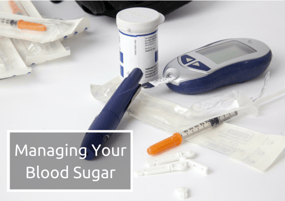Diabetes is a disease that touches many American lives. As of 2012, 9.3% of the American population had Type I or Type II diabetes, and many remain undiagnosed.
The condition results in high blood sugar and can result in other complications that can severely degrade a person’s health, and even result in death. In fact, in a 2010 study, diabetes was listed as the 7th leading cause of death in the U.S.
In order to prevent more severe health conditions, it is very important for those who suffer from diabetes to monitor their blood glucose levels. In patients with diabetes, this can help doctors prescribe the right medication, and regulate insulin levels.
But what is the best diabetes monitoring option for managing blood sugar?
Traditional Monitoring Options 
Traditional blood glucose meters involve a test strip that is inserted into the monitoring device. The patient then pricks a finger with a lancet to produce a drop of blood. The test strip collects the drop of blood and the machine reads the glucose level.
Generally, these meters are accurate and take 4-10 seconds to get a reading. These meters and test strips vary in price and insurance may limit the amount of test strips covered per month.
There are apps available now that can send the glucose readings directly to a physician so that he or she has the information prior to an in-office visit.
Newer Monitoring Options
A newer monitoring option for diabetes is a continuous glucose monitoring device (CGM). This device is comprised of a sensor that is placed under the skin of the abdomen. There are two different types of CGMs, a stand-alone device or one that is connected to an insulin pump.
CGM is a way to measure glucose levels in real-time throughout the day and night. A tiny electrode called a glucose sensor is inserted under the skin to measure glucose levels in tissue fluid. It is connected to a transmitter that sends the information via wireless radio frequency to a monitoring and display device. The device can detect and notify you if your glucose is reaching a high or low limit.
These devices are especially good for younger patients if connected to an insulin pump. If the blood sugar level gets too high or too low they have an alarm that will sound alerting the patient.
It is recommended that the patient calibrate their CGM system with traditional fingersticks 3–4 times per day for sensor accuracy. CGM does require at least 1 fingerstick blood glucose reading every 12 hours to calibrate the CGM sensor.
Which System is Right For Me?
It’s important to consider several factors when deciding on a diabetes monitoring device. Cost is one, as CGM devices are fairly expensive. But, if the patient is insulin dependent, it can be a great option to improve their qualify of life.
It’s best to discuss options with your doctor to find out the best treatment plan for managing blood sugar. Your doctor can make recommendations based on your needs, condition, and target HbA1c.
At Chase Medical Research, we currently have a number of diabetic clinical trials that we are now enrolling potential diabetic subjects. We are investigating very exciting and innovative therapies that may have a profound effect on diabetes care in the near future. Study related medication and treatments are provided at no-cost, and there is often compensation for time and travel.
If you're interested in seeing if you qualify for a diabetes clinical trial, click the button below.
Don't hesitate to contact us if you have any questions!
Share This Post
Recent Posts
- Obesity and Cardiovascular Disease: Is There a Link? June 26 2015
- Lp (a), A New Lab Test for Cardiovascular Risk June 26 2015
- Mediterranean Diet and Lifestyle Choices for Improved Health June 26 2015
- Understanding the Relationship Between Obesity & High Blood Pressure June 26 2015
- Cardiovascular Diseases Explained June 26 2015
Categories
- Clinical Trials
- Cardiovascular Disease
- Diabetes
- Obesity
- Kidney Disease
- Pain Management
- Female Sexual Dysfunction
- Hypertension
- Migraine
- Vaccine
- Chronic Obstructive Pulmonary Disease
- Osteoarthritis
- Biologics
- COVID-19
- Cholesterol
- Diabetic Peripheral Neuropathy
- Gastroesophageal Reflux Disease
- Irritable Bowel Syndrome with Constipation
- Lyme Disease
- Nonalcoholic Steatohepatitis
- Respiratory Syncytial Virus



